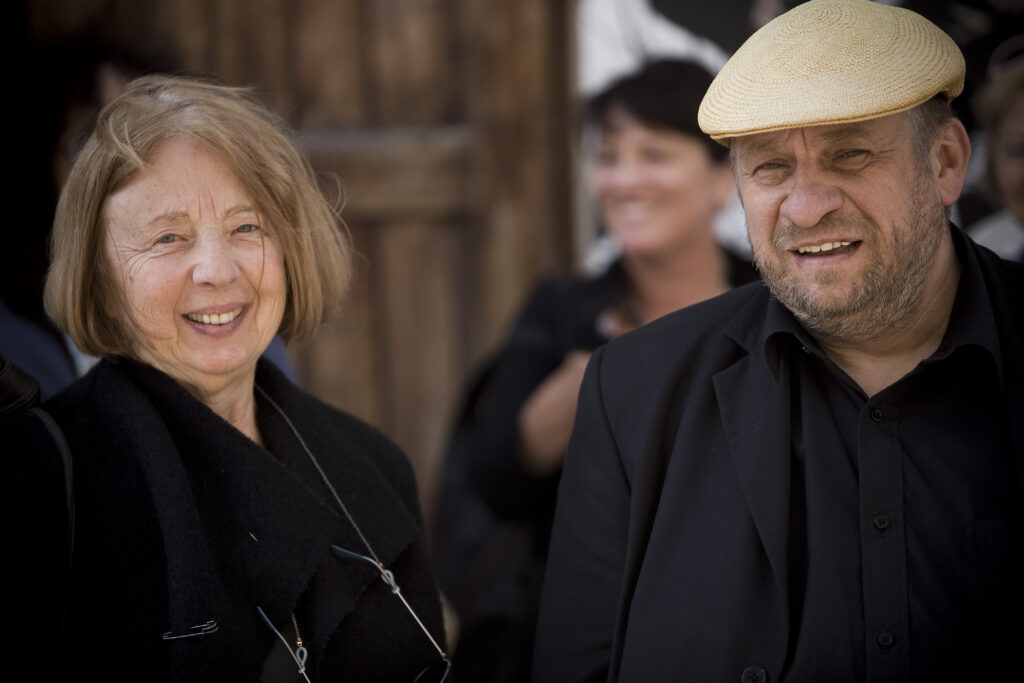gabriella cardazzo: the charm of a great art guardian
(1940 – 2024)

Gabriella Cardazzo and Leon Tarasewicz, 2009 (courtesy Grzegorz Dąbrowski)
The contemporary art world in Europe is currently in deep mourning, having lost one of its noble figures. Gabriella Cardazzo passed away in Trentino on the 4th of August, 2024, at the age of 85.
A Venetian gallery owner, contemporary art curator, photographer, filmmaker, and videographer, Gabriella took on the role of director of the Galleria del Cavallino in Venice at a very young age, alongside her brother Paolo, following the death of their father in 1963. (Editor’s note: The Venetian gallery became part of Italian contemporary art history thanks to their father, Carlo Cardazzo, who opened it in 1942, after establishing the Edizioni del Cavallino in 1935. In 1946, Cardazzo also opened the Galleria del Naviglio in Milan).
The siblings divided their responsibilities, working with emerging artists and forming enduring friendships. Paolo became a pioneer of video art in Italy, promoting, with his sister’s assistance, the first Italian videomakers and facilitating their interactions with international counterparts. Notably, the video art meetings organised in the mid-1970s in the Istrian town of Motovun have become significant milestones in the history of international video art. Gabriella, from the outset, was keen to exhibit British and American artists in Venice. She spent significant time in these countries, scouting talent and promoting exhibitions abroad for Italian artists. Her long-standing collaboration with the Richard Demarco Gallery in Edinburgh was particularly notable. The story of both siblings is one of virtuous friendships that lasted over time, marked by a natural generosity in the idealistic, collaborative atmosphere typical of the alternative cultural scenes of the 1970s. Gabriella documented these times as a photographer: her splendid 2020 book “Il tempo del cavallino” offers breathtakingly intimate portraits of great artists such as Joseph Beuys, Brian Eno, Dan Graham, Tadeusz Kantor, Les Levine, Patrick Procktor, and Joe Tilson. The book began as a collection of notes on photographs that had been digitised, intended to be added to the documents of the Fondo Cardazzo–Archivio del Cavallino, housed at the Fondazione Cini in Venice (which includes the archives of her father and brother, and hopefully, will soon include Gabriella’s personal archive, donated by the family).
Among all her connections, Tadeusz Kantor held a special place for Gabriella Cardazzo. They met in Scotland in the mid-1970s, introduced through their mutual friend Richard Demarco. (Editor’s note: In 1976, the Polish director’s production “The Dead Class” won first prize at the Edinburgh Festival), In 1985, Gabriella, who had been producing a series of videos about contemporary artists, travelled to Kraków, where Kantor allowed her to film a documentary about him. Over the next two years, she, along with Duncan Ward, followed Kantor’s international tours as if she were part of his theatre company. She eventually presented him with the edited film, which he greatly appreciated. The resulting documentary, “Kantor,” directed by Gabriella Cardazzo and Duncan Ward (London, 1987, 40 minutes), became one of the most profound and immersive explorations of Kantor’s complex theatrical world.
In the 1990s, Gabriella founded the cultural association ArtSpace, which operated for many years in Friuli. In 2011, it became an associate partner of the Trieste Contemporanea Committee. Gabriella’s fascination with 20th-century Polish art led to significant initiatives at Trieste Contemporanea, including in-depth studies on Tadeusz Kantor (from 2010 to 2020) and introducing Italian audiences to the work of Stanisław Ignacy Witkiewicz (2013). In 2021, she established the Paolo Cardazzo Award, an award for mid-career artists to produce a new project – still a rare type of prize in the Italian visual arts scene.
In recent years, Gabriella created and produced international projects that brought together artists’ reflections and emotions on socially relevant themes. For example, her research projects “À la frontière…! Old and New Borders in Europe” (2016) and “The Search for Identity in the Time of the Selfie” (2019), were first presented in individual sessions at Trieste Contemporanea before being exhibited in full at various public venues across Europe.
Gabriella Cardazzo, who chose to remain distant from the clamour of the art world, was always a contagious and attentive observer of contemporary developments and an extraordinary guide in recognising the spiritual dimension of art. Her friends and colleagues express their deep gratitude for her generous teachings, as well as their admiration and respect for the unique charm she brought to her work.